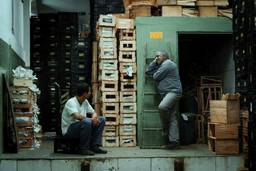From Ukraine’s Maidan to Edward Snowden in Hong Kong, Our Top 10 Films of 2014
Despite the ever-growing obsession with crappy remakes and computerized images of blowing shit up, the year featured some challenging, meaningful films.
Michael Atkinson

It’s been far from a special year, in terms of movies in America. A few more precious feet of cliff-edge were lost to the encroaching C.G.I. army-ant siege of comic-book boom-booms, distended sequels, half-hearted remakes, T.V. cinemizations, and movies adapted from toy lines. At the same time, there have been fewer great and challenging films than we can usually count on to act as toeholds in the onslaught. In short, movies built for nominally conscious teenagers rule an ever-growing territory, while cinema targeted at adults is becoming a ghetto, in both production and distribution.
It’s an old story, of course, but that only means it’s an incremental process decades in the making. The task at hand, however, is to assess upward, since year-end Top Ten lists aren’t meant to bury cinema but to praise it. Thus: here are my favorites of the past year.
1. Maidan (Sergei Loznitsa, Ukraine)
A gimlet-eyed, patient document of the 2013-2014 uprising in Kiev, which Loznitsa (arguably the greatest working post-Soviet filmmaker) caught with his implacable cameras without narration or interviews, from the ecstatic occupation of Kiev’s Maidan to the inevitable combat between bullets and grenades, and Molotovs and bricks. Enrapturing, devastating and always unemphatic, it’s an object lesson on how to capture history on film, and by far the best new film I saw in 2014.
2. Manakamana (Stephanie Spray & Pacho Velez, US/Nepal)
Another heartstopper from the Harvard Sensory Ethnography Lab, this formally radical documentary simply accompanies pilgrims to a mountaintop Hindu temple in Nepal, within an Alpine gondola (a trip that used to take three days but now takes 10 minutes). Up and down we go with the natives on holiday, in uncut journeys; we’re not told how to feel, but just provided with the experience of passing through the Himalayan air in good company.
3. Goodbye to Language (Jean-Luc Godard, Switzerland)
Grandpa Jean-Luc, the still-kicking Darwin of postmodern cinema, goes 3-D in this serene, autumnal meditation, and dares to one-up a tech-manic youth-world with usages and ideas no one’s ever come up with before. Just as enigmatic and faux-contemplative as his last decade of film, a self-dissecting essay about the unknowability of life and movies.
4. Closed Curtain (Jafar Panahi, Iran)
Under house arrest and banned from filmmaking for 20 years, Panahi continues making films covertly anyway. This mirror-mirror rumination on his own struggle to craft art in a society ruled by Iron Age maniacs was shot secretly in his beach house on the Caspian, and with its dreamy tension and real-world interpolations it never ceases to dazzle as an unarguably heroic objet de resistance.
5. Heli (Amat Escalante, Mexico)
Minimalist, stylized and yet as authentic as blood-beaded sand, Escalante’s new film, about a family sucked into Mexican drug cartel mayhem, is as unpredictable as it is, in certain moments, horrifying.
6. Winter Sleep (Nuri Bilge Ceylan, Turkey)
Ceylan is a film-festival giant, and this is his sixth near-masterpiece in a row, adapting Chekhov’s The Wife and Excellent People and exploring the moral and psychological stress ramping up between a wealthy ex-actor, his discontented young trophy wife and his aging sister in the scenic resort they own in the Taurus mountains. Despite the film’s physical beauty, it’s 100% character and acting.
7. Manuscripts Don’t Burn (Mohammad Rasoulof, Iran)
Another apostate in Iran, Rasoulof is also banned from making films, but made this scabrous drama instead while out on bail, eschewing Panahi’s metaphors and mysteries and limning a more conventional but explicit tale of state oppression, in which a government-ordained “disappearance” ruins both the victims and the hired agents carrying it out. It hasn’t been, and won’t be, seen in Iran.
8. Birdman (Alejandro Gonzalez Iñárritu, U.S.)
The best American film of the year? This happy excoriation of modern celebrity certainly has more than its fair share of brio, context, vivid inventiveness and performance octane, but it also comes hefting a fiercely adult personality, from its allusion-rich script to its ceaseless-take structure to the semi-improvised acting-about-acting.
9. Citizenfour (Laura Poitras, U.S.)
Is this even an American film, or is it stateless? After untold harassment, Poitras relocated to Germany, while co-conspirator Glenn Greenwald has expatriated to Brazil, and this scarifying and immediate doc was shot entirely in the Hong Kong hotel room where Edward Snowden unleashes his honesty onto the world. Orwellian in the most chilling sense.
10. Under the Skin (Jonathan Glazer, U.K.)
A moody, subterranean meta-genre exercise, following Scarlett Johansen around dark Scottish neighborhoods and seducing men – who are then led to a nebulously defined alien otherworld, and consumed. Undeniably bewitching.
My runners-up, in order because it’s only fun that way: Leviathan (Andrei Zvyagintsev, Russia), Mr. Turner (Mike Leigh, UK), Boyhood (Richard Linklater, US), Ida (Pawel Pawlikowski, Poland), Blue Ruin (Jeremy Saulnier, U.S.), Child’s Pose (Calin Peter Netzer, Romania), Stray Dogs (Tsai Ming-liang, Taiwan), Force Majeure (Ruben Ostlund, Sweden), Foxcatcher (Bennett Miller, US), Two Days, One Night (Luc and Jean-Pierre Dardennes, Belgium), Nightcrawler (Dan Gilroy, U.S.), Inherent Vice (Paul Thomas Anderson, U.S.), National Gallery (Frederick Wiseman, US/UK).
I wanted to like James Gray’s The Immigrant, Lav Diaz’s Norte, the End of History, Ben Russell and Ben Rivers’ A Spell to Ward Off the Darkness, and Wes Anderson’s The Grand Budapest Hotel much more than I eventually did, and couldn’t have tolerated Morten Tyldum’s The Imitation Game, Christopher Nolan’s Interstellar, J.C. Chandor’s A Most Violent Year, Damien Chazelle’s Whiplash or Woody Allen’s Magic in the Moonlight any less.
I tended to avoid movies targeted at children. Clearing away the building blocks and action figures, look what you get: My list harbors no less than four films that must be considered, in and of themselves, outright acts of political resistance. You don’t come by such things everyday, and we may not have seen such an uptick since the late ‘60s. (Of course, politically disruptive films might just proliferate when there’s more state injustice to buck up against.) In some crucial ways, movies can still matter.








